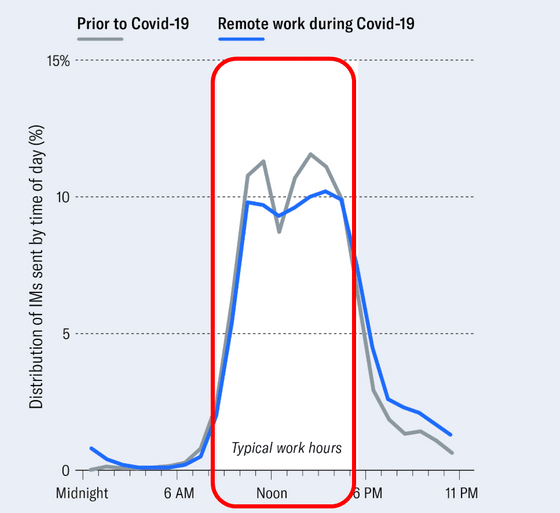What did Microsoft discover as a result of analyzing the changes after the introduction of remote work?

by
Microsoft has announced the results of its analysis of 'how the work styles of employees of the company have changed due to the remote work introduced as a countermeasure against the new coronavirus infection (COVID-19).'
Microsoft Analyzed Data on Its Newly Remote Workforce
https://hbr.org/2020/07/microsoft-analyzed-data-on-its-newly-remote-workforce
With COVID-19 raging in the United States, Microsoft introduced a remote work system in early March 2020. Microsoft describes the changes that COVID-19 has brought to work and in the classroom as 'no longer irreversible.'
Microsoft's view that the new coronavirus has permanently changed the way of working and learning, ``I can not return to it anymore''-GIGAZINE

Natalie Singer-Velush, marketing communications manager at Microsoft, said the 350 employees involved in Microsoft's service, Modern Workplace Transformation , are collaborating with other workplaces to investigate the impact remote work has had on the workplace. We have collected data about. The collected data included anonymized e-mail, schedule information, and instant message (IM) metadata. As a result, the following four changes have emerged.
◆1: Meeting shortened
What made Singer-Velush especially surprised was the transformation of the way meetings were held. Specifically, meetings that lasted less than 30 minutes increased by 22%, while meetings that lasted more than one hour decreased by 11%. Also, while the time of each meeting decreased, the number of meetings increased, and the total time spent at the meeting increased by 10%. Singer-Velush sees the result as 'because of the lack of well-end meetings near the hallway and coffee machines.'
Singer-Velush added, 'The shorter meeting time was caused by spontaneous changes, not by orders from the upper layers. The results of a survey that analyzes employee sentiment revealed that employees could increase this change. We show that we're evaluating. For future meetings that can last up to an hour, we'll have a tough eye as to whether it's really wise to spend such a long time.'
◆2: Managers had a hard time but had a good effect on their subordinates
According to Singer-Velush, managers were doubling their talk time from 7 hours a week to 14 hours a week in the Chinese workplace, where the transition to remote work took place earlier than the US headquarters. In addition, the number of IM exchanged by managers increased 115%, more than doubling.
In the United States, not only did managers spend more time on coordination, but the working hours of all employees increased, but for employees who have many one-to-one meetings with managers, the increase in working hours is significant. There were few.
Of the figures below, the upper graph shows the increase in the time spent on collaborative work by employees, and the lower graph shows the increase in the time spent in normal work on a weekly basis. In both graphs, the blue bar graph showing 'employees who have had many one-to-one meetings with managers' has only about half the black graph showing employees who do not, so we frequently communicate with managers. It can be seen that the employees who took them were able to suppress the increase in working hours due to remote work.

'The results mean managers were protecting their subordinates from the negative side of remote work by helping them prioritize and save time,' Singer-Velush said. ..
◆ 3: The border between work and private has become ambiguous
The following figure is a line graph showing the relationship between the number of IMs sent and received between employees and time.The gray line shows before COVID-19 occurs and the blue line shows after remote work started by COVID-19. is showing. Looking at the working hours surrounded by the red frame, the number of IMs that had a big peak before the remote work started was divided into two times, morning and afternoon, with a lunch break, but after the remote work started You can see that it is leveled. On the other hand, after remote work started, the number of IMs after 18:00 is also increasing.

About this result, Singer-Velush said, 'Before the pandemic, IM exchanges decreased by 25% due to the lunch break, but now it is only about 10%. On the other hand, IM from 18:00 to 24:00. Increased by 52%, and the number of employees with less than 10 minutes of collaborative work on weekends tripled, which may not seem like a big deal, It's a change in work culture that was neither intended nor desired.'
◆ 4: The connection between employees was not broken
Singer-Velush predicted that the remote work would significantly reduce the employee network, as the work environment and work rhythm of the employees changed. However, when we measured the breadth of human relations of 90,000 Microsoft employees who actually work in the United States, it was said that the human relations of most employees were not shrinking. On the contrary, many employees were expanding their relationships, and were able to interact not only with their own workplace but also with employees in other workplaces.
Some of the interactions Microsoft employees were making while they were working remotely were from having lunch at the same time, to being unique like 'pajamas day' and 'showing pets.' The number of such online exchanges increased by 10% in a month.
Singer-Velush says, “Affiliation is one of humanity's core desires, and feeling connected is motivating. That's why work relationships are so important. Connections help make employees feel happier, healthier, and build stronger networks.'
Singer-Velush added, ``It's still unclear if our way of working now is forever different than it was before COVID-19 and the introduction of the remote work system. But I'm convinced that learning about these changes is key to an organization's resilience in the coming months and years.”
Related Posts:
in Note, Posted by log1l_ks







